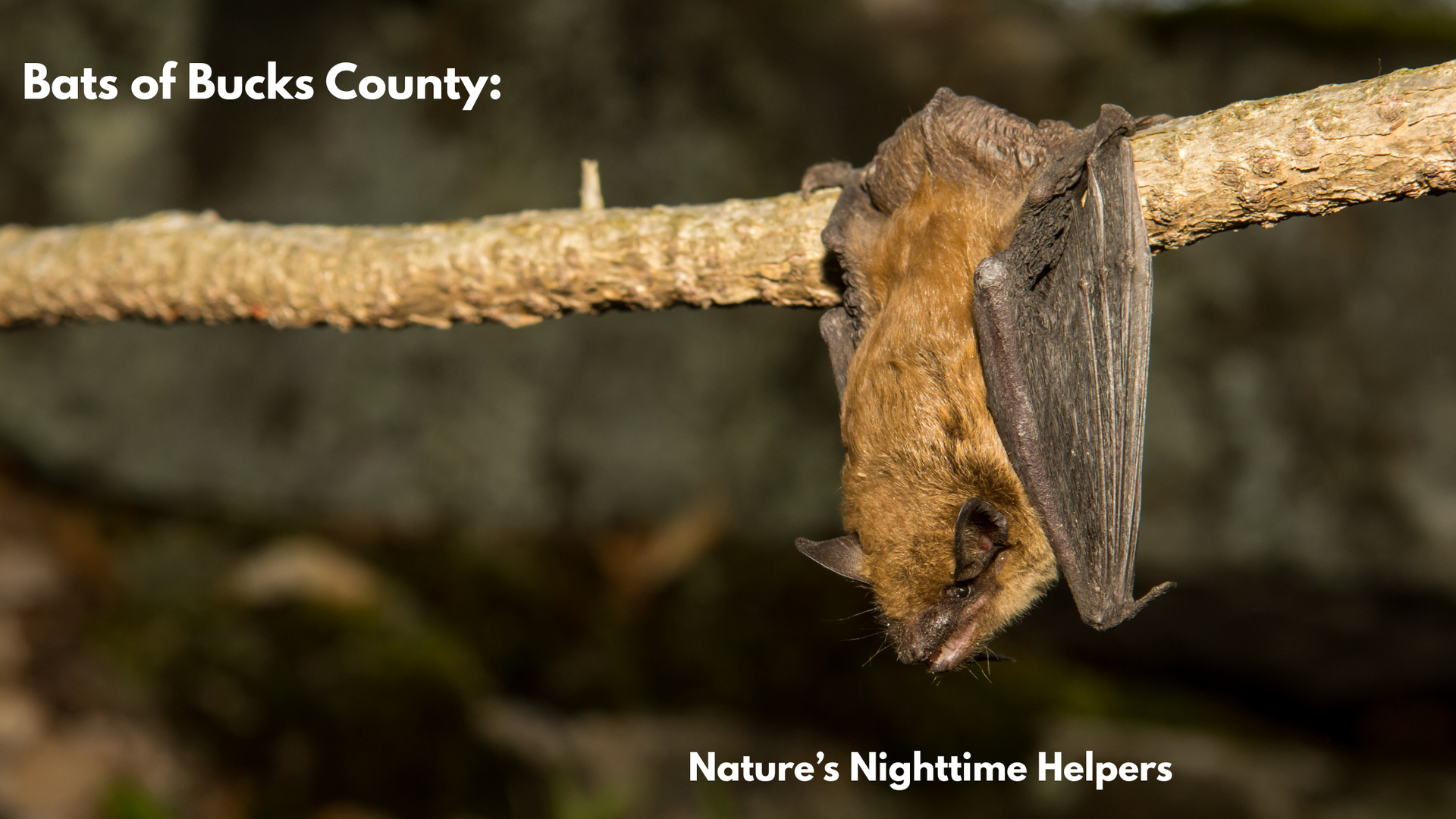
As the sun dips below the horizon and dusk settles over Bucks County, a quiet but important group of animals begins to stir. Bats—often misunderstood and sometimes feared—take to the skies, performing incredible aerial maneuvers as they search for food. These nocturnal mammals are vital to the health of our local ecosystems, and several species can be found right here in our backyards, parks, and forests.
Despite their critical role in nature, many of Pennsylvania’s bat species are in trouble. Habitat loss, pesticide use, and a
devastating disease called white-nose syndrome have dramatically reduced populations in recent years. That’s why it’s more important than ever to understand, appreciate, and protect the bats of Bucks County.
Bats You May See in Bucks County
Pennsylvania is home to nine species of bats, and many of them can be observed throughout Bucks County. One of the most common is the Big Brown Bat (Eptesicus fuscus), a hardy species often seen around buildings and neighborhoods. These adaptable bats can thrive in urban, suburban, and rural areas, making them one of the most familiar to local residents.
The Little Brown Bat (Myotis lucifugus), once abundant, has been hit hard by white-nose syndrome and is now considered vulnerable. These bats often roost in attics and barns and are known for their fast, erratic flight as they hunt mosquitoes and other flying insects.
The Eastern Red Bat (Lasiurus borealis) is another species found in Bucks County. This beautiful bat has reddish-orange fur and prefers to roost in the foliage of trees. Unlike many species, the red bat is solitary, typically only coming together with others during migration or mating season.
Some species, like the Hoary Bat (Lasiurus cinereus), may be more difficult to spot. These bats are the largest in Pennsylvania and are known for their striking silver-tipped fur. They are long-distance migrants and tend to roost high in the tree canopy, making them a rare but special sight.
Other bats found in our region include the Silver-haired Bat, Tricolored Bat, Eastern Small-footed Bat, Indiana Bat, and the Northern Long-eared Bat—some of which are threatened or endangered and rely on specific habitat types for survival.
Why Bats Matter
Bats provide an enormous service to both people and the environment. A single bat can consume up to 1,000 insects in just one hour, making them a natural and highly effective form of pest control. By reducing mosquito populations and consuming agricultural pests, bats help protect public health and save farmers billions of dollars annually in crop damage and pesticide use.
Beyond pest control, bats contribute to biodiversity and serve as indicators of environmental health. Healthy bat populations often reflect healthy ecosystems. In other parts of the world, bats are also essential pollinators and seed dispersers, particularly for plants that bloom at night.
In Bucks County, our local bats help keep insect populations in balance and contribute to the broader health of forest and wetland habitats. When we protect bats, we protect the systems that support countless other species, including our own.
Where and When to See Bats in Bucks County
The best time to see bats in action is around dusk on warm evenings from late spring through early fall. Bats are most active in June and July, when insect populations peak and pups begin learning to fly.
You don’t have to travel far to spot them. Parks like Peace Valley Park, Core Creek Park, and along Neshaminy Creek are excellent places to observe bats. Look toward open fields, forest edges, or over still water—anywhere bugs gather, bats are likely nearby. Their flight is quick and darting, often just a few feet off the ground. If you're lucky, you might even hear their high-pitched calls using a bat detector, a device that converts their echolocation clicks into audible sound.
How You Can Help Protect Bats
There are many simple and effective ways you can support bat conservation in Bucks County:
1. Install a Bat House
Providing a safe place for bats to roost can make a big difference, especially in areas where natural tree cavities or old buildings are scarce. Bat houses should be mounted 10–15 feet high in sunny locations with little nearby vegetation.
2. Preserve Natural Habitat
Dead trees (snags), loose bark, and old barns provide essential roosting sites. When safe to do so, leave these features in place to support bat populations.
3. Reduce Outdoor Lighting
Artificial lights can disrupt bats’ foraging behavior and disorient them. Use motion-activated or shielded lights to minimize impact.
4. Avoid Pesticide Use
Chemical pesticides harm the insects bats eat and can poison bats directly through secondary exposure.
5. Spread the Word
Many people fear bats unnecessarily. Sharing accurate information helps combat harmful myths and builds support for conservation.
6. Support White-Nose Syndrome Research
This fungal disease has devastated cave-dwelling bat populations in Pennsylvania. You can help by supporting conservation organizations working on habitat restoration and disease mitigation.
A Brighter Future for Bats
Bats are remarkable creatures—resilient, resourceful, and essential to the web of life in Bucks County. From farms to forests to backyard gardens, they work tirelessly each night to keep our ecosystems balanced and thriving. As threats to their survival grow, our actions can make a real impact. Whether it’s putting up a bat house, attending an educational bat walk, or simply letting others know how important bats are, each of us can play a role in ensuring that future generations can enjoy the wonder of bats in our night skies.




